My No-Till Garden
Published June 8, 2023. This post may contain affiliate links. Please read my disclosure policy.
It’s my second year of planting a garden, and I decided to take the advice of my many followers and opted for the famous no-till garden. This concept seems to be foolproof, and everything I read tells me I will render excellent results without a lot of hassle.
If you’re a big gardening fan, then you must check out my first-ever garden, where my parents come to town from Detroit to show me the ropes.
Garden Video
No-Till Garden
A no-till garden, also commonly called a no-dig garden, is a concept where you suppress the weeds by covering them and not agitating them like you would if you tilled them. You can then cover the garden with wood chips and decomposed leaves to help shield it from any unwanted weeds. A similar process is also called back to Eden gardening, which was created and named by Paul Gautschi, a Christian gardener.
The number one recommendation to me was to watch a man named Charles Dowding. In his videos, he goes into detail on how to do this and why it works. He claims the ground is full of nutrients and carbon that help plants flourish. When we till the ground, this releases all those nutrients and gives new life to weeds, which I can tell you firsthand after last year’s garden is a pain in the neck.
This process has been proven over and over again. However, I want to put it to the test to see if it actually works. Only time will tell. In addition, you’ll notice that I did away with all the grass in the backyard and replaced it with all mulch. I did this so I don’t have to worry about mowing back here. I also planted a pear, apple, cherry, and peach tree back there.
How to Make a No-Till Garden
Start by completely covering the area with flattened cardboard boxes, newspaper, or butcher paper, that you would like to start gardening.
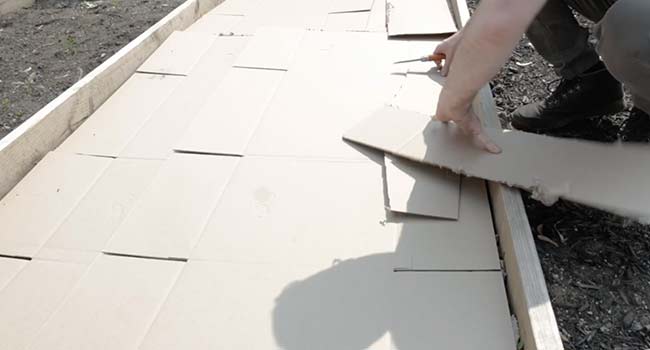
Next, spray down the boxes briefly with water to start the saturation process so that it breaks down.
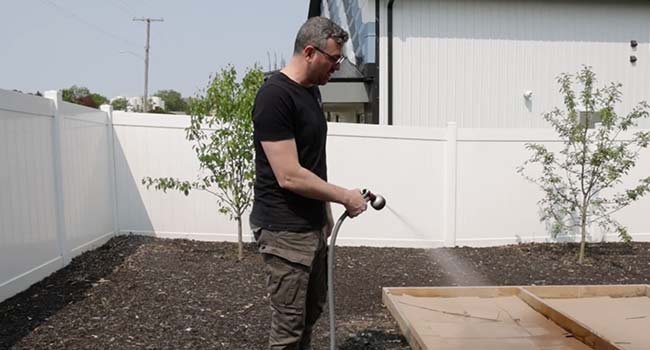
Now completely cover the cardboard with compost. I used a cow manure compost.
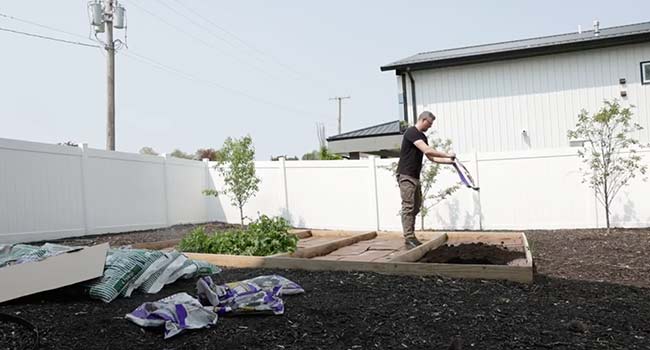
Flatten the compost by packing it in using a shovel, then give it a good soak.
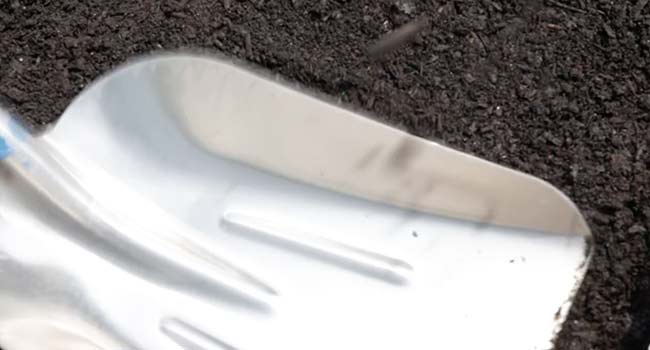
Next, cover that layer with good soil and likewise pack it in and give it a soak. Now you’re ready for planting.
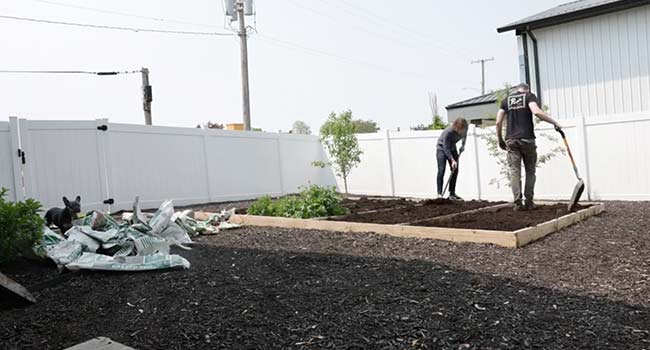
When planting, there are a few rules of thumb. First, know what plant hardiness zone you are in. Then, add your root vegetable seeds 3 inches apart from one another and in rows. They say that you only go down into the soil 3 times the size of the seed. I’m not sure that is gospel, so feel free to do what you are most comfortable with. I went down 1 to 2 inches. Be sure to cover the seeds with the soil you removed to plant the seed.
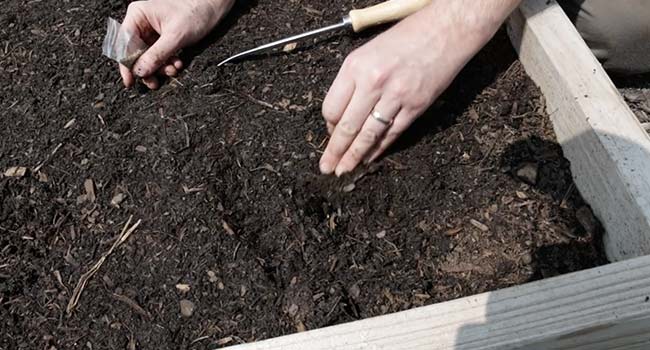
For bigger plants like peppers and beans, add your seeds 6-12 inches apart from one another. Finally, large plants like corn and cabbage go 12-18 inches apart from one another. Give the ground a suitable hose down to saturate the ground.
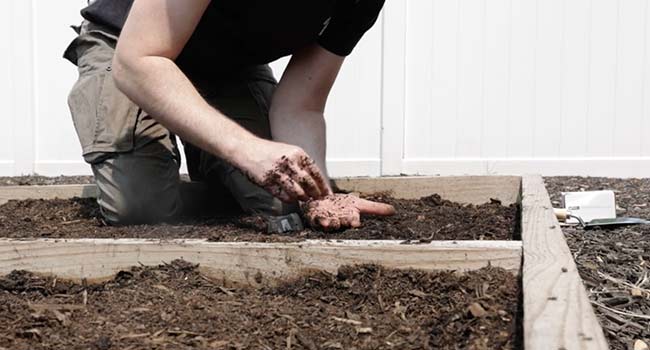
Lastly, be sure to label each row of what you planted there.
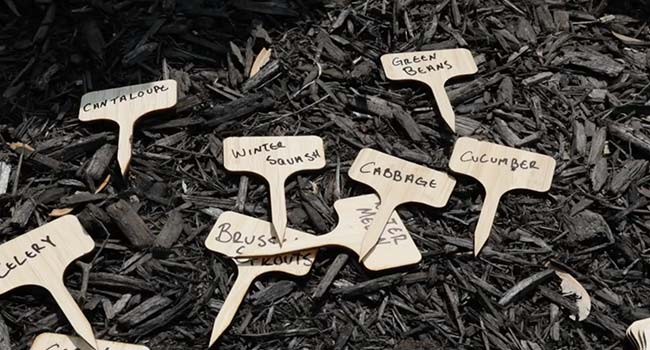
Wrapping Up
I just finished doing this garden a few weeks ago, and my goal is to do a midway recap and final recap and then feature recipes from freshly picked vegetables and fruit. Thank you for going on this journey with me. Please remember to subscribe to my YouTube Channel.

Chef Notes + Tips
- Charles Dowding says the cardboard takes 8 to 12 weeks to break down completely.
- This process will also work for pre-planted plants that are partially grown.
- Some weeds will still pop through, but it will be manageable and minuscule compared to a tilled garden.
- They say it’s best to start this process 10-12 weeks before you want to start planting.
- Once plants start to pop up, you can cover them with straw, decomposed leaves, or wood chips to help suppress the weeds even more.

Billy,
Now all you need is a bale of hay. Spread it around and between all your plants. It keeps down weeds, keeps the soil from heating up and fertilizes your plants as the hay breaks down. Just add more hay as the season progresses. This method was developed by Ruth Stout.
Thank you, Billy! I have raised beds and a larger area of garden i till. I am exhausted by all of the weeds I get. Last year I had some health issues and that area was densely covered with weeds 3 feet tall. I’m definitely trying out your No-Till technique!
Good Luck Billy. It’s so rewarding(although a bit expensive the 1st year or so, but so is the price of fresh veggies. Ours is very small, but is like yours in that we have a raised bed. We have enclosed ours w/plastic fencing & it helps to keep out the critters. We have only tomatoes & beans. We didn’t care as much for bush beans either, so trying pile beans this year. Only the 2 of us, so don’t need as much. Have a great summer.
Thank you for all the information I will try to use it to get a garden going, not to good at it. I also like planting flowers and landscaping.
My pleasure!
Great idea Chef Billy, I also have a garden like this one. I’m growing all kinds of Herbs,
squash of all kinds, tomatoes, big one and the Cherry tomatoes too, Cucumbers, carrots, potatoes, onions all kinds, String beans, Radishes, I have a Lemon tree, a Lime tree, I have a Black Cherry Tree, an orange tree, a kumquat tree and a Blueberry bush. I love it it is so relaxing to work in the garden, I love using all my Herbs in cooking and the vegetables too. Good Luck on your Beautiful garden Chef, It looks really nice so far….
You have the Italian flat bean. I planted Creole Tomatoes. They are Great. I plant radish in the beds to keep insects on the plants. You can put basil, dill and radish. I have a hot house to. I love it. If you have any questions.
What an awesome idea!
I garden to. I have raised beds. I have three. I plant in containers. I have beautiful plants and tomatoes. I have learned a lot from your message. Thank you
Hi Chef. Thank you for your post. I too planted a no till garden not a big or nice a yours, but am enjoying the Swiss chard and peas already. Wishing you fun and success and looking forward to any tips you might have. Love your fruit trees! Thank you for always sharing your talents with us.
Dear Billy
I grew up with the most wonderful, kindest and loving parents. They were immigrants from Platania, Calabria Italia. They never spoke fluent English so my language in the house was always Italian. In the spring and as a young girl my father and I used to go outside in the back yard ( near Pittsburgh , PA) to begin our garden. This brings back the exact memory of how we planted our garden. Flattened boxes everywhere! No plastic then! Then cow manure and I remember the smell! The only thing my PaPa did not do was label. He knew what he planted and where they were. All seeds began in the basement
(cellar) of our house. What memories of JOY!! Thank you. Thank you for all of your recipes and your honest cooking. Blessings to you and your family.
I’m 82 now and the memories of my precious parents live on every day.
Rose DeFazio Dancu